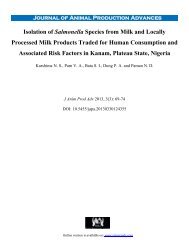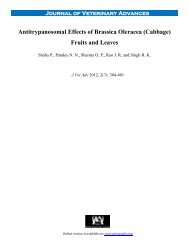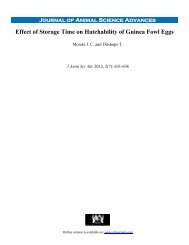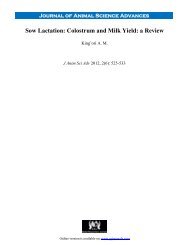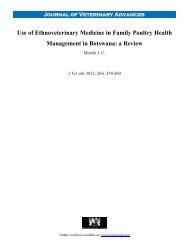PDF Download
PDF Download
PDF Download
Create successful ePaper yourself
Turn your PDF publications into a flip-book with our unique Google optimized e-Paper software.
Journal of Animal Science Advances<br />
Effect of Graded Levels of Mexican Sunflower Leaf (Tithonia<br />
Diversifolia Hemsl.A. Gray) Meal on the Feed Intake of Ewe<br />
during the Entire Lactation Period of 90 Days<br />
Ekeocha A. H.<br />
J Anim Sci Adv 2012, 2(9): 727-733<br />
Online version is available on: www.grjournals.com
ISSN: 2251-7219<br />
EKEOCHA<br />
Effect of Graded Levels of Mexican Sunflower Leaf<br />
(Tithonia Diversifolia Hemsl.A. Gray) Meal on the<br />
Feed Intake of Ewe during the Entire Lactation<br />
Period of 90 Days<br />
Abstract<br />
Ekeocha A. H.<br />
Department of Animal Science, University of Ibadan, Ibadan, Nigeria.<br />
Original Article<br />
A 90 – day feeding trial was conducted to evaluate Mexican Sunflower leaf (MSL) as dietary fiber source<br />
in sheep diets. Straight diets were formulated to contain the MSL at dietary levels of 0%, 15%, 30% and 45% as<br />
replacement for wheat bran. Sixteen (16) West African dwarf ewe weighing 19.50 to 22.46kg were allotted to<br />
the 4 diets containing four replicates per treatment with 1 ewe per replicate in a completely randomized design<br />
(CRD). Ewes were given ad libitum access to feed and water and routine vaccination and medication followed<br />
standard procedures. Parameters measured were changes in feed intake during early, mid and late lactation,<br />
Feed Conversion Ratio (FCR) and DM : LW %. Data were analyzed using descriptive statistics and ANOVA.<br />
There were significant (p diet D (17.60kg) although no statistical significance<br />
(P>0.05) was observed. There was no significant correlation between live-weight at mating and duration of<br />
pregnancy or live-weight at mating and lambs birth weight. Inclusion of up to 30% MSLM in the diets of<br />
lactating ewe appeared most beneficial to sheep as it had no negative effects on dry matter and nutrient intake.<br />
Keywords: Mexican sunflower leaf, feed intake, lactation period<br />
Corresponding author: Department of Animal Science, University of Ibadan, Ibadan, Nigeria<br />
Received on: 22 Aug 2012<br />
Revised on: 05 Sep 2012<br />
Accepted on: 15 Sep 2012<br />
Online Published on: 30 Sep 2012<br />
727 J. Anim. Sci. Adv., 2012, 2(9):727-733
EFFECT OF GRADED LEVELS OF MEXICAN SUNFLOWER LEAF …<br />
Introduction<br />
Lactation plays an important role in the life of<br />
sheep. Apart from provision of milk for humans,<br />
lactation is an indication of good lamb performance.<br />
Owen (1981) reported that the main difference in<br />
lamb growth arising from lactation is due to<br />
variation in the yield of milk. Poor quality feed<br />
especially during the dry season has been identified<br />
as one of the major constraints to small scale dairy<br />
production (Barje et al., 1999).<br />
In most animals not specialized for milk<br />
production, the composition of milk is, apart from<br />
vitamins, is largely independent of the quality of the<br />
diets, any inadequacy or shortages being reflected<br />
by a diminished yield (McDonald et al., 1987).<br />
Sheep milk composition can also be influenced by<br />
different feeds, grazing systems and by subclinical<br />
mastitic conditions (Bufano et al., 1996). Milk<br />
composition of major and minor components is<br />
affected by feeding regimes, ration components and<br />
forage : grain ratios (Perea et al., 2000). Studies by<br />
Ekeocha et al., 2012 have shown that lactating West<br />
African dwarf ewes fed on Mexican sunflower leaf<br />
meal based diets have substantial mineral profile at<br />
her disposal.<br />
However, research emphasis worldwide has<br />
been on sheep wool and meat production and their<br />
characteristics, not on sheep milk.<br />
Most textbooks on “Milk” deal only with cow<br />
milk, and human milk to some extent (Kon and<br />
Cowie, 1961; Falconer, 1971; Renner, 1982;<br />
Gravert, 1983). The only major sources of research<br />
information on sheep milk appear to be the bulletins<br />
and proceedings of the International Dairy<br />
Federation Seminars held in Greece in 1985 and<br />
1995 (IDF, 1983; 1986; 1996). Not even the 1 st<br />
World Congress of Dairy Products in Human<br />
Health and Nutrition (Serrano Rios, 1994)<br />
recognized the existence or contribution of sheep<br />
milk products to human nutrition, nor does the<br />
handbook of the US Sheep Industry Development<br />
Program (Scott, 1986). In France, the scientific<br />
journal Le Lait devoted an entire issue to goat milk,<br />
including its role as an alternative to cow milk (Le<br />
Lait, 1993). A biobliography on goat milk (Freund,<br />
2000), and the proceedings of a national colloquium<br />
on the nutritional and dietetic qualities of goat milk<br />
(Freund, 1996) have been published, but similar<br />
efforts on sheep milk are still missing. Even a book<br />
on buffalo milk is available (Deepak Sahai, 1996).<br />
Searching the CAB for the past 10 years, the<br />
numbers of publications worldwide on sheep milk,<br />
sheep cheese and allergies related to sheep milk are<br />
minor compared to those on cow milk (King, 1988).<br />
Certainly there are more publications in earlier<br />
years, but those would be based on less<br />
sophisticated analytical methods. Publications on<br />
the nutritional value of sheep milk often give only<br />
gross composition without detailed identification of<br />
more specific unique components of benefit in<br />
human nutrition, although trade magazines contain<br />
many anecdotal reports that are waiting for<br />
scientific evaluation. However, among the 1,000<br />
research projects on sheep worldwide (King, 1988),<br />
less than 4% deal with topics of sheep milk and<br />
sheep dairying.<br />
This experiment is aimed at evaluating feed<br />
intake and weight change from WAD ewes fed<br />
MSLM based diets during lactation.<br />
Materials and Methods<br />
Experimental Site<br />
This study was carried out at the sheep unit of<br />
the University of Ibadan Teaching and Research<br />
farm.<br />
Management of Experimental Animals<br />
Sixteen WAD ewes aged between 16 - 17<br />
months and weighing 19.50 – 22.46kg were used.<br />
The management of experimental animals was same<br />
as for the feeding trial.<br />
Oestrus Synchronisation<br />
Oestrus was artificially synchronized in all the<br />
animals using Dinoprost tromethanine solution<br />
PGF 2 -Tuco products, Canada),<br />
administered intra-muscularly in two doses of 1ml<br />
given 19 days apart. Rams bred at the sheep unit of<br />
Teaching and Research farm were introduced once<br />
signs of heat were detected. Mating was allowed<br />
before 08.00hrs and after 18.00hrs to minimize heat<br />
stress on the rams. All ewes were weighed at mating<br />
and monthly thereafter till parturition and continued<br />
till end of lactation.<br />
728 J. Anim. Sci. Adv., 2012, 2(9):727-733
EKEOCHA<br />
Routine Observed During Lactation Trial<br />
At parturition, the dams were weighed, lambs<br />
were weighed and their sex was recorded.<br />
Thereafter lambs were weighed weekly.<br />
The ewes were group penned and fed during<br />
the period of the lactation trial. At every 4 th , 8 th and<br />
12 th week, each ewe was weighed individually<br />
penned and total feed intake was taken for that<br />
week. Clean water was constantly available<br />
throughout the experimental period. Ewes were then<br />
reweighed and returned to their group pens. This<br />
was continued till end of lactation.<br />
Statistical Analysis<br />
Data obtained were subjected to analysis of<br />
variance (ANOVA) using the General Linear Model<br />
(GLM) of SAS software (SAS, 1999). Treatment<br />
means were compared by Duncan option of the<br />
software.<br />
Table 1: Ingredient composition of experimental diet<br />
Ingredients %<br />
Rations<br />
A B C D<br />
MSLM 1 0.00 15.00 30.00 45.00<br />
Wheat bran 45.00 30.00 15.00 0.00<br />
Cassava peel 33.20 33.20 33.20 33.20<br />
Palm kernel meal 10.00 10.00 10.00 10.00<br />
Ground nut cake 10.00 10.00 10.00 10.00<br />
Oyster shell 0.50 0.50 0.50 0.50<br />
Bone meal 0.50 0.50 0.50 0.50<br />
Mineral/Vit. Premix 0.30 0.30 0.30 0.30<br />
Common salt 0.50 0.50 0.50 0.50<br />
MSLM=Mexican Sunflower Leaf Meal, A = 0%MSLM, B =15% MSLM, C =<br />
30% MSLM, D = 45% MSLM<br />
Table 2 : Proximate composition of experimental diet<br />
Constituents %<br />
Rations<br />
A B C D<br />
Dry matter 92.00 91.00 90.00 89.00<br />
Crude protein 17.10 16.90 16.50 16.20<br />
Crude fiber 15.70 16.40 17.00 17.50<br />
Ether extract 3.47 3.63 3.70 3.75<br />
Ash 8.60 9.40 10.10 11.30<br />
NFE 1 55.13 53.67 52.70 51.25<br />
ADF 2 22.54 26.70 30.85 35.01<br />
NDF 3<br />
ADL 4 43.15<br />
7.92<br />
44.50<br />
8.41<br />
45.85<br />
9.03<br />
47.20<br />
9.85<br />
Gross energy(kcal/kg) 3829.5 3805.5 3781.0 3735.5<br />
1 NFE= nitrogen free extract<br />
2 ADF= acid detergent fiber<br />
3 NDF= neutral detergent fiber<br />
4 ADL = acid detergent lignin<br />
729 J. Anim. Sci. Adv., 2012, 2(9):727-733
EFFECT OF GRADED LEVELS OF MEXICAN SUNFLOWER LEAF …<br />
Table 3: Chemical Composition of Dried Mexican Sunflower Leaf Meal (MSLM),<br />
Wheat bran and Panicum maximum<br />
Components MSLM Wheat bran Panicum maximum<br />
Dry matter 89.00 89.00 26.00<br />
Crude protein (CP) 16.33 17.00 7.95<br />
Crude fiber (CF) 21.80 8.50 31.00<br />
Ether extract (EE) 2.81 3.50 4.00<br />
Ash 14.68 13.01 8.90<br />
NFE 1 44.38 57.99 48.15<br />
ADF 2 42.63 25.00 42.70<br />
NDF 3 60.00 51.00 74.30<br />
Hemi cellulose 17.37 26.00 31.60<br />
ADL 4 9.96 8.60 13.87<br />
1 NFE= nitrogen free extract<br />
2 ADF= acid detergent fiber<br />
3 NDF= neutral detergent fiber<br />
4 ADL= acid detergent lignin<br />
Table 4: Anti Nutritional Factors in MSLM<br />
Component<br />
Quantity (mg/100g)<br />
Total Alkaloid 6.32<br />
Saponin 1.05<br />
Oxalate 5.25<br />
Phytate 8.81<br />
Tannin 5.19<br />
Glycosides 0.42<br />
Phenol 0.53<br />
Source: Ekeocha (2009)<br />
Results and Discussion<br />
Feed Intake<br />
The chemical composition of grass (Panicum<br />
maximum) and the concentrate supplements are<br />
presented in (Tables 2 and 3). Dry matter intake<br />
(DMI) at early, mid and late lactation is presented in<br />
Table 5. Average total DMI (g/d) increased<br />
gradually from average values of 503.29, 782.81,<br />
562.39, and 441.82g/day in early lactation to<br />
512.69, 797.44, 572.91, and 450.06g/day in mid<br />
lactation and decreased slightly to average values of<br />
493.90, 768.20, 551.90, and 433.56g/day in late<br />
lactation for animals on diets A, B, C and D<br />
respectively.<br />
Dietary effects on total DMI were not<br />
significant (P
EKEOCHA<br />
Table 5: Feed intake of ewe during lactation (g/day)<br />
Treatment A(0%MSLM) B(15%MSLM) C(30%MSLM) D(45%MSLM) SEM<br />
Early Lactation<br />
Concentrate 356.14 ab 604.57 a 319.17 ab 204.74 b 213.81<br />
Grass 147.15 b 178.25 b 243.23 a 237.08 a 35.76<br />
Total DMI 503.29 782.81 562.39 441.82 226.17<br />
DMI g/dWkg 0.75 106.26 147.99 115.49 96.37 69.36<br />
DM ÷ LW% 2.55 3.86 2.70 2.27 1.12<br />
Mid Lactation<br />
Concentrate 362.80 ab 615.87 a 325.13 ab 208.57 b 219.81<br />
Grass 149.90 b 181.58 b 247.77 a 241.51 a 43.61<br />
Total DMI 512.69 797.44 572.91 450.06 240.00<br />
DMI g/dWkg 0.75 107.74 150.06 117.10 97.71 70.32<br />
DM ÷ LW% 2.73 3.96 2.94 2.44 1.20<br />
Late Lactation<br />
Concentrate 349.50 ab 593.30 a 313.20 ab 200.92 b 209.82<br />
Grass 144.39 b 174.92 b 238.68 a 232.64 a 35.09<br />
Total DMI 493.90 768.20 551.90 433.56 221.94<br />
DMI g/dWkg 0.75 104.77 145.92 113.87 95.01 68.28<br />
DM ÷ LW% 2.77 3.83 2.90 2.46 1.18<br />
ab means on the same row with different superscripts differ significantly (P0.05) with increasing inclusion of<br />
MSLM. Kruip-Tam et al (1996) earlier enunciated<br />
the occurrence of an apparently unavoidable post<br />
partum negative nutrient balance in animals selected<br />
for milk yield. The combination of increasing<br />
demand for milk yields and insufficiently increased<br />
feed intake capacity led to a gap between energy<br />
input and energy output at the onset of lactation<br />
which could only be compensated for by lipolysis<br />
and protein mobilization from body tissues resulting<br />
in net loss in weight. Owens (1981) further<br />
highlighted that the requirements of a ewe in peak<br />
lactation are approximately three times those of a<br />
dry ewe. However, it is normally impracticable to<br />
increase the energy concentration of the diet<br />
sufficiently to match this increased demand<br />
particularly since ewe in the first 3-4 weeks of<br />
lactation have not reached maximum voluntary feed<br />
intake. Observed variations were not significant<br />
(P>0.05) on reproductive performance although<br />
animals on treatment B was superior to others in<br />
weight at parturition, lamb birth weight, shorter<br />
gestation length and weight gain during pregnancy.<br />
Conclusions<br />
Mexican sunflower leaves provides an<br />
opportunity to enhance utilization of the fibrous<br />
fraction, and to raise the overall protein and energy<br />
density of ruminant diets thus sparing wheat bran<br />
which is unsustainable all year round due to<br />
seasonal effect. There will also be potential for<br />
indirect environmental benefits from making greater<br />
use of MSL in ruminant diets, because of the<br />
environmental pollution associated with burning of<br />
MSL. However, this potential will only be realized<br />
in practice when the improved supply of digestible<br />
energy at the level of the rumen is reflected in<br />
improved animal performance, which requires a<br />
concomitant improvement in the balance of<br />
essential nutrients available for metabolism by the<br />
animal and possibly production of meat. Based on<br />
the overall performance, inclusion of 15% Mexican<br />
sunflower leaf meal in the diets of lactating ewes<br />
appeared most beneficial to sheep as it improved<br />
dry matter intake and reproductive performance but<br />
731 J. Anim. Sci. Adv., 2012, 2(9):727-733
EFFECT OF GRADED LEVELS OF MEXICAN SUNFLOWER LEAF …<br />
incorporation of up to 30% Mexican sunflower leaf<br />
meal in the diets of sheep to replace Wheat bran<br />
was adequate for lactation.<br />
Table 6: Reproductive performance of WAD ewe fed MSLM based diets<br />
Parameters<br />
A(0%MSLM) B(15%MSLM) C(30%MSLM) D(45%MSLM) SEM<br />
Initial wt before growth trial (kg) 14.10 14.00 14.30 14.00 2.78<br />
Wt at mating (kg) 17.63 17.50 17.88 17.50 3.48<br />
Wt at parturition (kg) 23.23 26.03 24.45 22.80 3.95<br />
Wt after parturition (kg) 19.80 22.46 20.85 19.50 3.59<br />
Gestation length (days) 150.00 149.50 150.50 150.00 0.82<br />
Lamb birth wt(kg) 1.65 1.80 1.80 1.59 0.38<br />
Wt loss during parturition (kg) 3.43 3.57 3.60 3.30 0.42<br />
Wt gain during pregnancy (kg) 5.60 8.53 6.58 5.30 0.97<br />
Wt of dam at mid lactation (kg) 18.80 21.46 19.50 18.43 3.41<br />
Wt of dam at weaning (kg) 17.80 20.66 19.00 17.60 3.27<br />
Wt changes during lactation (kg) -2.00 -1.80 -1.85 -1.90 0.40<br />
SEM: Standard error of mean<br />
References<br />
AFRC (1992). Agricultural and Food Research Council.<br />
Technical Committee on Response to nutrients. Rep. No.<br />
9 Nutritive requirements of ruminant animals: Protein<br />
Nutri. Abstr. Rev. Ser. B. Livest. Feeds Feeding 62: 787-<br />
835.<br />
AOAC (1990). Association of Official Analytical Chemists<br />
1970, Pennsylvania State University Press, University<br />
Park, PA, 467 pp.<br />
Freund G (ed.) (1996). Interets nutritionnel et dietetique du lait<br />
de chevre. Proceedings, Colloquium Le Lait de Cherve,<br />
Niort, Nov. 7, 1996, Institut. National de la Recherche<br />
Agronomique Publ., Paris, No. 81, 199 pp.<br />
Freund G (ed.) (2000). Goat Milk: Composition and<br />
Nutritional Value; Caprine Resources and<br />
Documentation Center of Institut. Technique des Produit<br />
Laitiers Caprins Publ., Surgeres, France, 78 pp.<br />
Gravert HO (1983). Die Milch. Verlag Eugen Ulmer,<br />
Stuttgart, 387 pp.<br />
IDF (1983). Production and Utilization of Goat’s and Ewe’s<br />
Milk. International Dairy Federation Publ., Brussels,<br />
Bul. No. 158, 72pp.<br />
IDF (1986). Production and Utilization of Goats and Ewe’s<br />
Milk Proceedings, IDF Seminar, Athens, Greece, Sept.<br />
23-25, 1985, International Dairy Federation Publ.,<br />
Brussels, Bul. No. 202, 222pp.<br />
IDF (1996). Production and Utilization of Ewe and Goat Milk.<br />
Proceedings, IDF Seminar, Crete, Greece, Oct. 19-21,<br />
1995. International Dairy Federation Publ., Brussels,<br />
346pp.<br />
King JWB (1988). directory of Current Research on Sheep<br />
and Goats. Commonwealth Agricultural Bureaux<br />
International Publ., Wallingford, Oxon, U.K. 271 pp.<br />
Kon SK, Cowie AT (1961). Milk: The Mammary Gland and<br />
its Secretion. Academic Press, New York, NY, 2 vol.,<br />
938pp.<br />
Kruip T, Werf JHJ, Vander-Wensing T, Groen AF (1996).<br />
Energy balance in early lactation of high producing dairy<br />
cows and its relation to reproduction, health and welfare.<br />
Proc. of the Wageningen Inst. Of Anim. Sci.<br />
Wageningen, Netherlands, 45-57, EAAP Publ. No.<br />
84:43.<br />
Le Lait (1993). Le Lait de chevre. Internat. J. Dairy Sci. and<br />
Technol. Le Lait 73: 405-628.<br />
official methods of Analysis, 15 th Ed. AOAC Inc.<br />
Arlington, Virginia USA.<br />
ARC (1985). Agricultural Research Council. The nutrient<br />
requirement of farm animals No.2 Ruminants: Tech Rev.<br />
and Summaries, ARC, London.<br />
Barje PP, Ehoche OW, Oyedipe EO, Agyemang K, Adu IF,<br />
Hailu Z, Rekwot PI (1999). Evaluate of pen-urban diary<br />
production systems in Nigeria: Results of the Diagnostic<br />
Survey phase, Final Report ILRRI, Ibadan.<br />
Bufano G, Dario C, Laudadio V (1996). The characterization<br />
of leccese sheep variations of chemical composition and<br />
lactodynamographic parameters in milk as related to<br />
somatic cell counts. In: Proceedings, International<br />
Symposium, Somatic Cells and Milk of Small Ruminants<br />
R. Rubino, Ed., Bella, Italy, Sept. 25-27, 1994,<br />
Wageningen Pers, EAAS Publ. No. 77, pp. 301 -304.<br />
Deepak S (1996). Buffalo Milk, Chemistry and Processing<br />
Technology. Shalini International Publication, Karnal,<br />
Haryana, India, 268 pp.<br />
Ekeocha AH (2009). Utilization of Mexican Sunflower<br />
(Tithonia diversifolia, Hemsley A. Gray) By the West<br />
African Dwarf Sheep. Ph.D Thesis, University of Ibadan,<br />
Ibadan, Nigeria, 224pp.<br />
Ekeocha AH, Fakolade P (2012). Studies on the<br />
physicochemical and Mineral Profile of Lactating West<br />
African Ewe fed Mexican Sunflower Leaf Meal Based<br />
Diets. J. Rec. Adv. Agri. 1 (4): 146 – 156.<br />
Falconer IR (1971). Lactation. Proceedings, International<br />
Symposium on Lactation, University of Nottingham,<br />
McDonald P, Edwards RA, Greenhalgh JFD (1987). Animal<br />
732 J. Anim. Sci. Adv., 2012, 2(9):727-733
nutrition 4 th Ed. Longman Scientific and Technical. John<br />
Wiley and Sons. Inc. New York.<br />
Owen JB (1981). Sheep Production LPE pp. 195-235 Bailliese<br />
Tindall Publ. Cassell Ltd. London.<br />
Perea S, Labastida EF de, Najera AI, Chavarri F, Virto M,<br />
Renobales M de, Baron LJR (2000). Seasonal changes in<br />
the fat composition of Lacca sheep’s milk used for<br />
idiazabal cheese. Europ. Food Res. Technol. 210:318-<br />
323.<br />
Renner E (1982). Milk and Milk Products in Human Nutrition.<br />
Volkswirtschaftlicher Verlag GmbH Publ., Munich,<br />
Germany, 467 pp.<br />
SAS (1999). SAS/STAT Guide for personal computers.<br />
Version 6 S.A.S. Inst. Inc. Cary. New York, USA.<br />
Scott GE (1986). The Sheepman’s Production Handbook.<br />
Sheep Industry Development Program and American<br />
Sheep Producers Council Publ., Denver, C. O. 382 Pp.<br />
Serrano Rios M, Sastre A, Perez Juez MA, Estrala A,<br />
Sebastian C De Eds (1994). Proceedings, 1 st World<br />
Congress Dairy Production in Human Health and<br />
Nutrition, Madrid, June 7 – 10, 1993, A. A. Balkema<br />
Publ., Rotterdam, 447 Pp.<br />
Steele M (1996). Goats, the tropical Agriculturists. CTA<br />
publication. Macmillan pp. 9-21.<br />
Tarawali SA, Tarawali G, Larbi A, Harrison J (1995).<br />
Methods for the evaluation of forage-legume grasses,<br />
and fodder trees for use as livestock feed. ILRI Manual<br />
J. ILRI Nairobi Kenya. 7-15.<br />
Van Soest PJ (1963). Use of detergents in the analysis of<br />
fibrous feeds. 11. A rapid method for the determination<br />
of fibre and lignin. J. Assoc. Off. Anal. Chem. 46: 829-<br />
835.<br />
Van Soest PJ, McQueen RE (1973). The chemistry and<br />
estimation of fibre. Proc. Nutr. Soc. 32: 123-127.<br />
EKEOCHA<br />
733 J. Anim. Sci. Adv., 2012, 2(9):727-733





